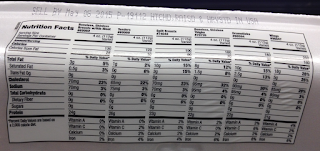Academic politics, like any other type of politics, is better served by words that are evocative and ambiguous, but if an argument is transparently political, economists interested in science will simply ignore it. The style that I am calling mathiness lets academic politics masquerade as science. Like mathematical theory, mathiness uses a mixture of words and symbols, but instead of making tight links, it leaves ample room for slippage between statements in natural versus formal language and between statements with theoretical as opposed to empirical contentBrad DeLong has had some sharp comments, but I think the best reply to Romer's critics came from Romer himself.
If you think that what McGrattan and Prescott do for location is even remotely on the same level as what Solow did for capital or what Becker did for human capital, please go read the two M-P papers (JET 2009, AER 2010.)
When you think you are too stupid to understand what they are saying and want to give up, trust me, it isn’t you. What they are saying makes no sense. No one can understand it. The authors do not understand it.
Here is a sample of what you can expect:
Technology capital is distinguished from other types of capital in that a firm can use it simultaneously in multiple domestic and foreign locations. (Footnote: In the language of classical general equilibrium theory, a unit of technology capital is a set of technologies, with one technology for each location.) (JET 2009, p. 2455)
“A unit … is a set”? This is just gibberish. Forget about whether the model connects in any meaningful way to the real world. There is no way to make sense of this statement even in the make-believe world of the model. In the model, the authors define technology capital is a cardinal measure. It is supposed to be something that you can have 2 units of, or 4, or 10. What could 2 or 4 or 10 sets of technologies possibly mean?
We assume that the measure of a country’s production locations is proportional to its population, since locations correspond to markets and some measure of people defines a market. (JET 2009 p. 2461)
I feel guilty pulling a quote like this one, as if I’m humiliating some miserable undergraduate by reading to the class from a term paper on a project that fell apart. But remember, this is from an article that was published in the Journal of Economic Theory.
As you read this quote, remember that the motivation for the theory is that for these authors, perfect competition is the ultimate non-negotiable, more sacred even than micro-foundations. If this were a Hotelling model of location or a Krugman model of spatial location, I’d have some way to try to make sense about how “some measure of people defines a market.” But in the formal mathematical model of perfect competition that the authors are using, this sentence means nothing.
These words are untethered, undisciplined by logic or math, chosen to sound plausible enough to someone who is not paying close attention, like the set up for an applause line in a speech by a politician. This is mathiness.
There is lots more:
One unit of technology capital and z units of the composite input at a given location produce y = g(z). Consider the case of brand equity with units of technology capital indexed by m. For ease of exposition, assume for now that m is discrete and that m = 1 is the Wal-Mart brand, m = 2 is the Home Depot brand, and so on. Wal-Mart chooses the locations in which to set up stores and use its brand. It may be the case that both Wal-Mart and Home Depot have stores at the same location. (AER 2010, p. 1497.)
And if you look at the math, a company like Wal-Mart has to use one unit of technology capital for each location. Because the number of locations in the US is the US population, Wal-Mart must be using more than 300 million units of technology capital. (So more than 300 million technology sets?)
How can we reconcile the math with words that say Wal-Mart gets index m=1 and Home Depot gets m=2? And if technology capital is brand equity, why does Wal-Mart need another unit of brand equity for each US citizen/location? I haven’t a clue, but neither do the authors. One of the things that Milton Friedman got right was his observation that “confused writing is a sign of confused thinking.”
As a discussant, I put serious effort into trying to clean up the mess in the working paper that became the 2009 JET paper. I worked through the math. I talked with the authors.
The things I explained, such as how to convert any concave function like g(z) into a function with one additional variable that is homogeneous of degree one, just helped them put lipstick on this pig.
It was an embarrassment for me that the 2007 NBER version contained the acknowledgement “Discussions with Robert Lucas and Paul Romer were extremely helpful…”
One thing has been bothering me for years now is not just that economists often combine overly simplistic modeling assumptions with overly complicated math (we all do that from time to time), but that many seem to equate these things with thinking scientifically.On the mathematical point, go back and look at “is economics a science?” debates and see how long it takes someone on the pro side to bring up how mathematically sophisticated their work is. You will frequently hear this same argument made by astrologers and other fringe science types and it has no less validity there than it does here.
This is not to say that economics is a fringe or even a soft science. While I'm not going to get into the relative hardness of different disciplines (always a waste of time), I will say that econ is a fascinating field full of smart people doing sound and important work.
My concerns are more cultural and meta. I'll try to come back and fill in some of the details later (I've got a lot on my plate now, if you'll pardon the pun), but just to paint it in broad strokes, these attitudes not only make economics look bad, they lead to all sorts of bad things like epicyclic modeling and, in the final stages, mathiness.
Which brings us to the double talk of Sid Caesar, the famous bits where he would seem to be speaking in various languages. The words were complete gibberish but by mimicking the inflection and rhythm (what he called the 'song') of each language, he could could create the impression of going from French to German to Russian and so on.
I realize Romer is making some bigger points here, but in at least one aspect, this reminds me of those Caesar routines. Instead of musical qualities, mathiness uses linguistic properties like vocabulary and syntax to create the impression of scientific reasoning. It is only when you pay attention that you realize nothing is being said.


















